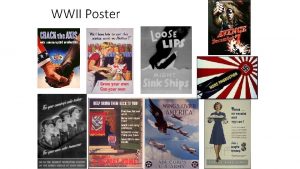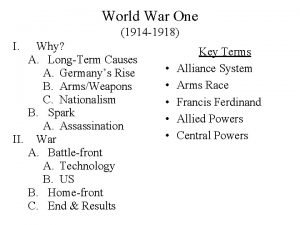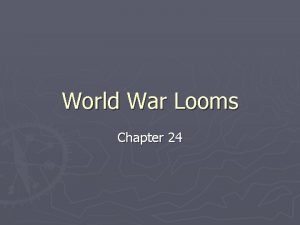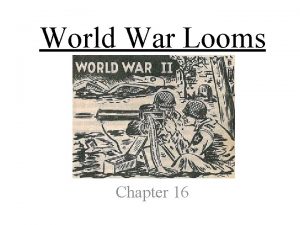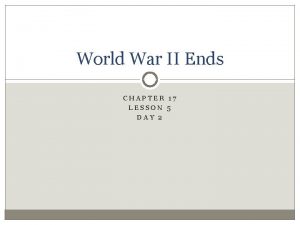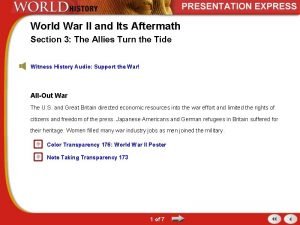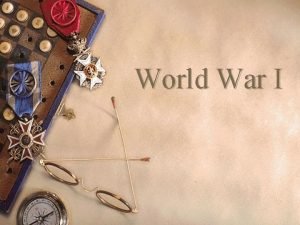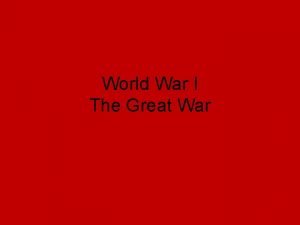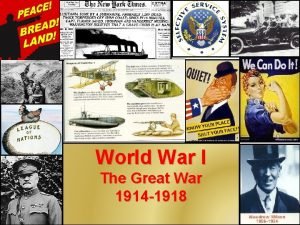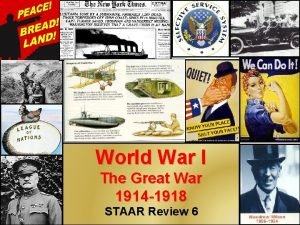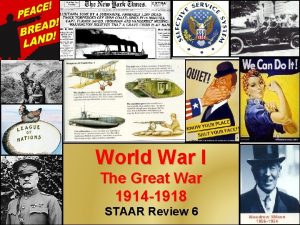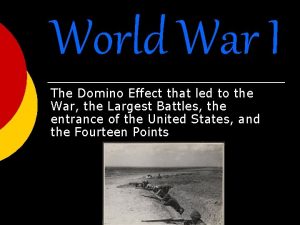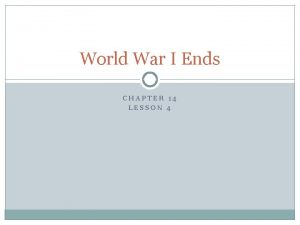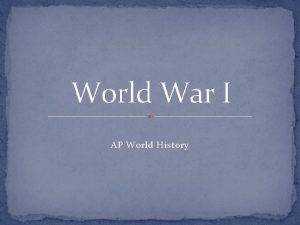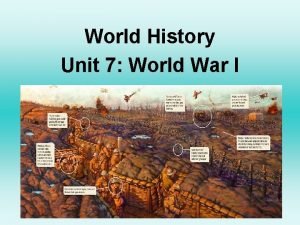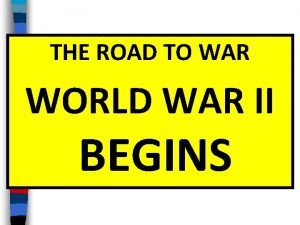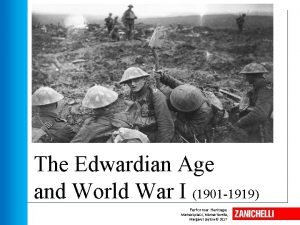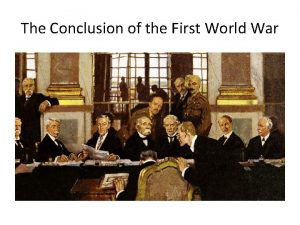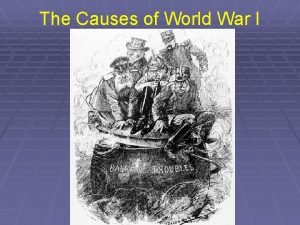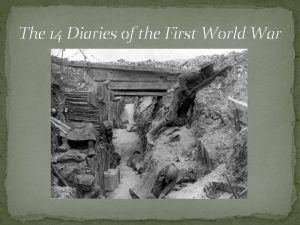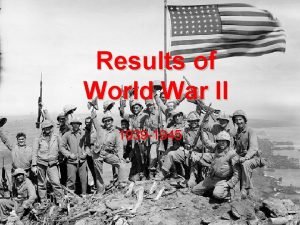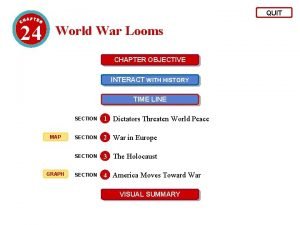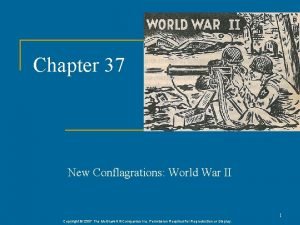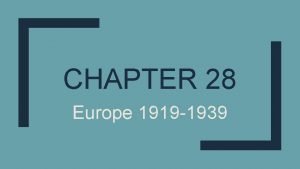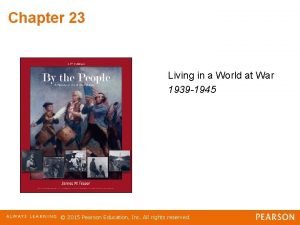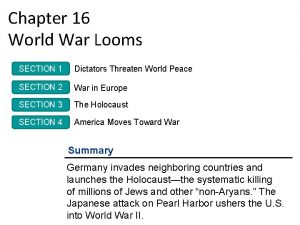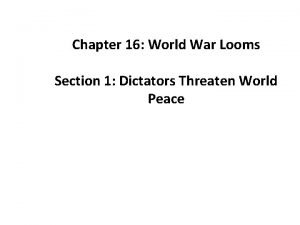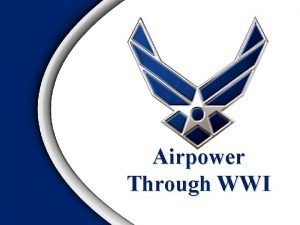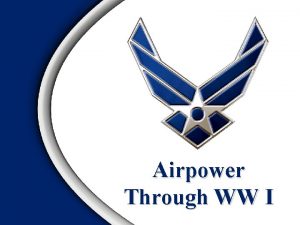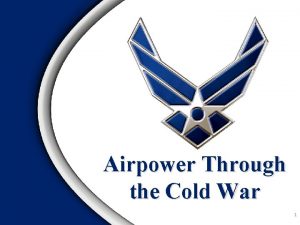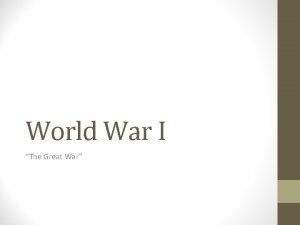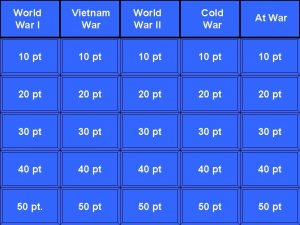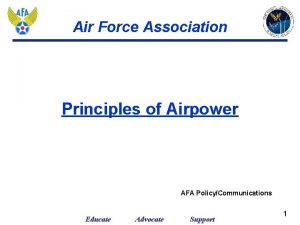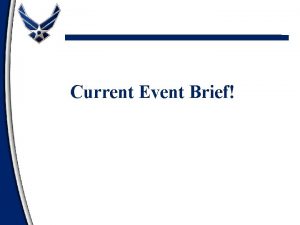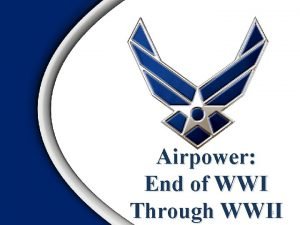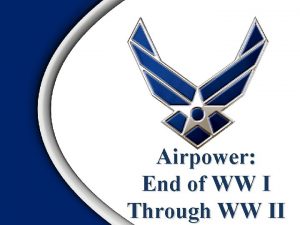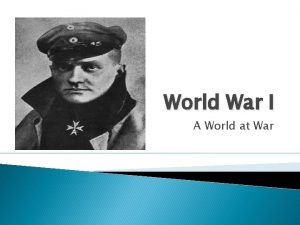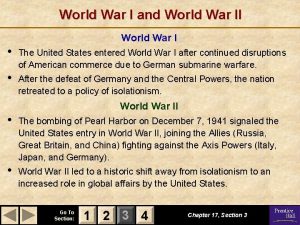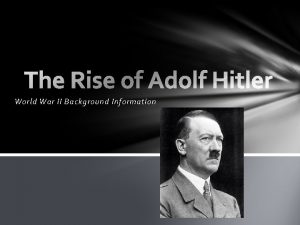Airpower in World War I How much information




















































- Slides: 52

Airpower in World War I

How much information do you already know about this topic area? A. Expert – I have done a lot of learning in this area already. 0 B. Above average – I have learned some information about this topic. 0 C. Moderate – I know a little about this topic. 0 D. Rookie – I am a blank slate…but ready to learn! 0 AS 100 -C 2 L 1: LQ 1

Which country was part of the Central Powers? A. B. C. D. Russia France Serbia Turkey 0 0 A. B. C. D. AS 100 -C 2 L 1: LQ 2

Chapter Overview Ø Lesson 1: Airpower in World War I Ø Lesson 2: Expanding the Horizon from Barnstormers to Mainstream Ø Lesson 3: Early Developments in Commercial Flight Chapter 2, Lesson 1

Lesson Overview Ø The contributions of American pilots during World War I Ø How the airplane revolutionized war Ø New developments in aviation during World War I Ø How the war sped up aviation development in the United States Chapter 2, Lesson 1

Vocabulary Questions Slide Index (Part 1 of 2) Click any link below to go directly to polling that question. 1. Russia, France, Serbia, and Britain 2. Germany, Austria-Hungary, and Turkey 3. Short for “undersea boats, ” the name given to German submarines 4. A small squadron of planes 5. An automatic rifle that uses belt-fed ammunition 6. A situation in which further action is blocked 7. To set aside for a specific use Click here to return to this index.

Vocabulary Questions Slide Index (Part 2 of 2) Click any link below to go directly to polling that question. 8. Designed to strike at the sources of an enemy’s military, economic, or political power 9. A battle between fighter planes 10. Attack with a machine gun from a low-flying aircraft Click here to return to this index.

Quick Write Faced with seven German planes against his one, Eddie Rickenbacker knew he must remain calm. Why do you think that was important? What lesson do you think you can learn for use in emergencies you might face? (Note to teacher: Click the Show/Hide Response Display Button) Photo courtesy of Shutterstock

The Outbreak of World War I Ø A Serb assassinated Austrian Archduke Franz Ferdinand Ø Russia, France, Serbia, and Britain were Allies Ø Germany, Austria-Hungary, and Turkey were Central Powers Chapter 2, Lesson 1

The Outbreak of World War I, cont. Ø President Woodrow Wilson vowed United States would remain neutral Ø That proved impossible Ø Germany targeted all American ships headed toward Britain Ø Germany asked Mexico to make war with United States Ø President Wilson asked Congress to declare war on Germany Chapter 2, Lesson 1 Photo courtesy of Shutterstock

Which country was included in the Allies? A. B. C. D. Germany Russia Turkey Austria-Hungary 0 0 A. B. C. D. AS 100 -C 2 L 1: LQ 3

Why did President Wilson ask Congress to declare war on Germany? A. B. C. D. Germany targeted all American ships headed toward Britain Germany asked Canada to make war with the United States Turkey had declared war on United States Mexico joined Germany in the war 0 0 A. B. C. D. AS 100 -C 2 L 1: LQ 4

The Lafayette Escadrille Ø In 1916 American pilots formed the Escadrille Américaine Ø Germany protested United States was breaking its promise of neutrality Ø Changed name to the Lafayette Escadrille Chapter 2, Lesson 1 Photo courtesy of Library of Congress

Activity 1: The Lafayette Escadrille Ø Review the section in your textbook on the Lafayette Escadrille Ø Answer the questions Ø Create your own insignia for the fuselage of your plane Chapter 2, Lesson 1

Raoul Lufbery Ø Most famous pilot of the Lafayette Escadrille Ø 17 combat victories during war Ø Lufbery gave two pieces of advice to new pilots: ØDon’t lunge headfirst into combat ØIf your plane is burning, try to land for a better chance of survival Ø Sadly, did not follow own advice Chapter 2, Lesson 1 Photo courtesy of Library of Congress

Edward Rickenbacker Ø Started out as a professional racecar driver Ø Enlisted as staff car driver Ø Did two important things for his men: ØGot them parachutes ØFigured out how to keep airplane’s machine gun from jamming Chapter 2, Lesson 1 Photos courtesy of US Air Force

Edward Rickenbacker Ø After war stayed in reserves Ø Bought the Indianapolis 500 speedway Ø In 1938, bought Eastern Airlines Ø Spent last years promoting military and civilian aviation Chapter 2, Lesson 1 Photo courtesy of US Air Force

What advice did Lufbery give to new combat pilots? A. B. C. D. Lunge headfirst into combat Remain calm and evaluate the situation Try to bring a burning plane in for landing rather than jump Jump if a plane is burning 0 0 A. B. C. D. AS 100 -C 2 L 1: LQ 5

What important thing did Rickenbacker do for his men? A. B. C. D. Got them equipped with parachutes Installed machine guns on their planes Flew solo to protect his men Convinced the US to invest in more airplanes 0 0 A. B. C. D. AS 100 -C 2 L 1: LQ 6

Frank Luke Ø Frank Luke was a wildcard Ø Completed nine-week flight training in seven weeks Ø Sometimes went off by himself Ø Died 17 days after his first kill Ø Shot down 15 balloons and three airplanes Chapter 2, Lesson 1 Photo courtesy of US Army

Eugene Bullard Ø Only African-American pilot during war Ø First signed up with French Foreign Legion Ø After fourth wound, sent to French Air Service Ø First black man and to get pilots license Ø First African-American fighter pilot Chapter 2, Lesson 1 Photo courtesy of US Air Force National Museum

Eugene Bullard Ø Spoke English, French, and German Ø After war, spied on Germans living in France Ø Fled Paris before Germans invaded Ø Fought with French until wounded Ø Smuggled out of France and sent back to United States Ø Spent rest of life in Harlem, New York as an elevator operator Ø Grateful French government never forgot him Chapter 2, Lesson 1 Photo courtesy of US Air Force Enlisted Heritage Hall

Activity 2: Members of the Lafayette Escadrille Ø Select one of the members of the Lafayette Escadrille Ø Use the Internet to research your chosen member Ø Prepare a short biography on the selected pilot Chapter 2, Lesson 1

US Contributions to the Air War Ø By 1917 war in Europe was at a stalemate Ø US Congress appropriated $64 million to build airplanes Ø US lacked engineers and manufacturers for planes Ø Entered war with 100 pilots Ø Had 10, 000 trained pilots by war’s end Chapter 2, Lesson 1 Photo courtesy of Shutterstock

How the Airplane Revolutionized War Ø Most people thought role of aircraft was aerial reconnaissance Ø Airplane reshaped way countries fight wars Chapter 2, Lesson 1 Photos courtesy of US Air Force

The Long-Range Raid and the Machine Gun Ø Through 1917 Germans worked on perfecting long-range strategic raids Ø Germans flew hydrogen-filled zeppelins ØIs very flammable ØUsed to drop bombs Ø Developed a twin-engine bomber – Gotha IV Chapter 2, Lesson 1 Photo courtesy of Shutterstock

Aerial Combat Ø Aerial combat was born from need to protect aerial aircraft Ø French first to bolt rifle on aircraft Ø Germans quickly picked up on airplane-mounted machine gun Ø Machine guns on planes were also used to strafe soldiers Chapter 2, Lesson 1 Photo courtesy of Shutterstock

The Battle of Saint Mihiel Ø September 1918 Ø Brigadier General Billy Mitchell commanded nearly 1, 500 Allied airplanes Ø Had two goals: ØDestroy German planes in the air ØDestroy German aircraft on the ground Caproni Ca. 36 bomber Chapter 2, Lesson 1 Photo courtesy of US Air Force

Activity 3: The Battle of Saint Mihiel Ø Use the Internet to locate an article of the Battle of Saint Mihiel Ø Select one article and answer the questions Chapter 2, Lesson 1

The Birth of New Strategies Ø Airplanes now offered possibilities Ø Could fly over trenches and bomb from overhead Ø Could bomb factories Ø Could provide element of surprise Chapter 2, Lesson 1 Photo courtesy of Shutterstock

What was the major weakness of zeppelins? A. They were very slow B. They were not sturdy C. They easily burst into flames D. They could not carry machine guns 0 0 A. B. C. D. AS 100 -C 2 L 1: LQ 7

What was one of the goals of the Battle of Saint Mihiel? A. B. C. D. Destroy German camps Destroy German planes in the air and on the ground Participate in as many dogfights as possible Get Allies troops behind enemy lines through bombing 0 0 A. B. C. D. AS 100 -C 2 L 1: LQ 8

New Developments in Aviation During World War I Ø By 1918 three specialized types of aircraft emerged: 1. Fighter 2. Observation 3. Bomber Chapter 2, Lesson 1 Photo courtesy of Shutterstock

New Developments in Aviation During World War I, cont Ø Birth of the monoplane fighter Ø Seven months before war ended Ø Hugo Junkers built all-metal, low-wing monoplane Ø No longer a need for wood and fabric fighters Chapter 2, Lesson 1 Photo courtesy of Shutterstock

How the War Sped Up Aviation Development Ø Brigadier General Billy Mitchell strongly believed in future of aviation Ø Mitchell’s three-pronged theory: ØAir superiority over battlefield ØAirpower employed offensively ØAerial bombardment Chapter 2, Lesson 1 Photo courtesy of US Air Force

Who built the first all-metal low-wing monoplane? A. B. C. D. Lois Blériot Eddie Rickenbacker Hugo Junkers William Mitchell 0 0 A. B. C. D. AS 100 -C 2 L 1: LQ 9

What was one of Billy Mitchell’s three pronged strategies to fight wars? A. B. C. D. Air superiority was not important Air superiority over the battlefield must be assured Airpower should only focus on bombing military targets Airpower should be used as a defensive weapon only 0 0 A. B. C. D. AS 100 -C 2 L 1: LQ 10

Activity 4: Aviation Development During World War I Ø Review the section in your textbook on new developments in aviation during World War I Ø Match the type of aircraft to the aircraft type Ø Answer the questions Chapter 2, Lesson 1

Summary Ø The contributions of Americans pilots during World War I Ø How the airplane revolutionized war Ø New developments in aviation during World War I Ø How the war sped up aviation development in the United States Chapter 2, Lesson 1

How do you think Mitchell’s theory to flight wars impacted the use of military aviation today? Note to Instructors: Click the Show/Hide Response Display Button AS 100 -C 2 L 1: LQ 9

What parts of this lesson were the hardest to understand? What parts were the easiest? Note to Instructors: Click the Show/Hide Response Display Button AS 100 -C 2 L 1: LQ 10

Next…. v Done – Airpower in World War I v Next – The expanding horizon from barnstormers to mainstream Chapter 2, Lesson 1 Photo courtesy of Shutterstock

Russia, France, Serbia, and Britain (p. 61) A. B. C. D. Allies Europe Central Powers Neutral Powers 0 0 AS 100 -C 2 L 1: VQ 1

Germany, Austria-Hungary, and Turkey (p. 61) A. B. C. D. Allies Europe Central Powers Neutral Powers 0 0 AS 100 -C 2 L 1: VQ 2

Short for “undersea boats, ” the name given to German submarines (p. 61) A. B. C. D. U-boats Maritime boats Marine boats Oceanic boats 0 0 AS 100 -C 2 L 1: VQ 3

A small squadron of planes (p. 63) A. B. C. D. Strategic Escadrille Stalemate Appropriate 0 0 AS 100 -C 2 L 1: VQ 4

An automatic rifle that uses belt-fed ammunition (p. 65) A. B. C. D. Pistol Firearm Revolver Machine gun 0 0 AS 100 -C 2 L 1: VQ 5

A situation in which further action is blocked (p. 69) A. B. C. D. Strategic Escadrille Stalemate Appropriate 0 0 AS 100 -C 2 L 1: VQ 6

To set aside for a specific use (p. 69) A. B. C. D. Strategic Escadrille Stalemate Appropriate 0 0 AS 100 -C 2 L 1: VQ 7

Designed to strike at the sources of an enemy’s military, economic, or political power (p. 70) A. B. C. D. Strategic Escadrille Stalemate Appropriate 0 0 AS 100 -C 2 L 1: VQ 8

A battle between fighter planes (p. 72) A. B. C. D. Strafe Dogfight Escadrille Aerial battle 0 0 AS 100 -C 2 L 1: VQ 9

Attack with a machine gun from a low-flying aircraft (p. 72) A. B. C. D. Strafe Dogfight Escadrille Aerial battle 0 0 AS 100 -C 2 L 1: VQ 10
 How much
How much To whom much is given much is expected meaning
To whom much is given much is expected meaning How much is too much plagiarism
How much is too much plagiarism The world is too much with us paraphrase
The world is too much with us paraphrase The world is too much with us themes
The world is too much with us themes Structure of the world is too much with us
Structure of the world is too much with us War at home vs war abroad madison
War at home vs war abroad madison Korean war vietnam war venn diagram
Korean war vietnam war venn diagram Welcome 1 unit 10 lesson 1
Welcome 1 unit 10 lesson 1 Truman doctrine and marshall plan venn diagram
Truman doctrine and marshall plan venn diagram Josette dugas war of 1812
Josette dugas war of 1812 Ich war du warst er sie es war
Ich war du warst er sie es war Force and motion study jams
Force and motion study jams Civil war first modern war
Civil war first modern war Ich war du warst er sie es war
Ich war du warst er sie es war Chapter 16 lesson 2 challenges to slavery
Chapter 16 lesson 2 challenges to slavery Proxy wars in the cold war
Proxy wars in the cold war Chapter 30 the war to end war
Chapter 30 the war to end war Chapter 30 the war to end war
Chapter 30 the war to end war Bandwagon propaganda world war 2
Bandwagon propaganda world war 2 Results of the world war 1
Results of the world war 1 Building vocabulary world war looms
Building vocabulary world war looms Chapter 16 world war looms vocabulary
Chapter 16 world war looms vocabulary Lesson 5 world war ii ends
Lesson 5 world war ii ends World war 2 and its aftermath section 1 quiz
World war 2 and its aftermath section 1 quiz World war 2 brain pop
World war 2 brain pop World war 1 and the russian revolution chapter 27
World war 1 and the russian revolution chapter 27 World war 1 participants
World war 1 participants 3 cause of ww1
3 cause of ww1 What was the cause of world war 1
What was the cause of world war 1 Causes of world war 1
Causes of world war 1 Domino effect ww1
Domino effect ww1 Lesson 4 world war 1 ends
Lesson 4 world war 1 ends Total war world history definition
Total war world history definition Triple entente countries in world war 1
Triple entente countries in world war 1 What is thesis statement
What is thesis statement Causes of world war 2
Causes of world war 2 From the edwardian age to the first world war
From the edwardian age to the first world war Conclusion of ww1
Conclusion of ww1 Long term causes of world war 2
Long term causes of world war 2 What was the cause of world war 1
What was the cause of world war 1 Arte 14 - diaries of world war i
Arte 14 - diaries of world war i Results of the world war 1
Results of the world war 1 Chapter 24 world war looms section 1 answers
Chapter 24 world war looms section 1 answers School uniform of sshs prior to the second world war
School uniform of sshs prior to the second world war Result of world war 2
Result of world war 2 World war 1 conclusion
World war 1 conclusion Chapter 37 new conflagrations world war ii
Chapter 37 new conflagrations world war ii Lesson 1 instability after world war 1
Lesson 1 instability after world war 1 Chapter 24 world war looms section 1 answers
Chapter 24 world war looms section 1 answers Chapter 23 living in a world at war
Chapter 23 living in a world at war Chapter 16 building vocabulary world war looms
Chapter 16 building vocabulary world war looms Stalin vs mussolini venn diagram
Stalin vs mussolini venn diagram



















